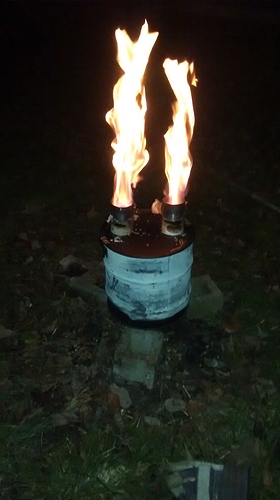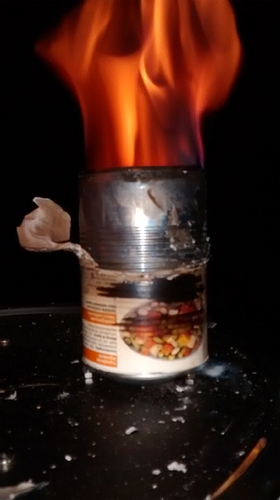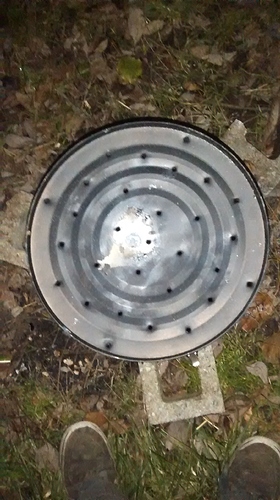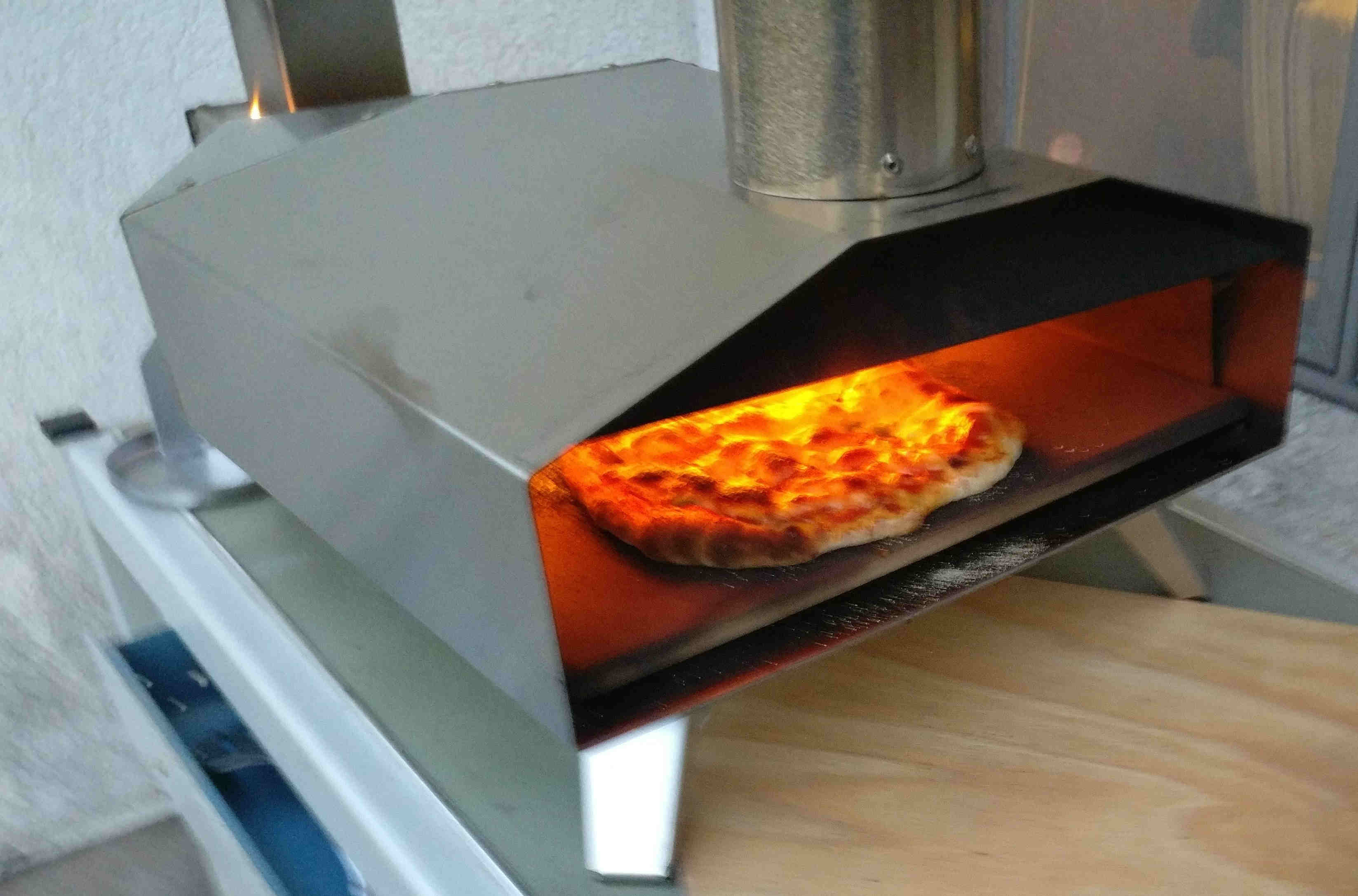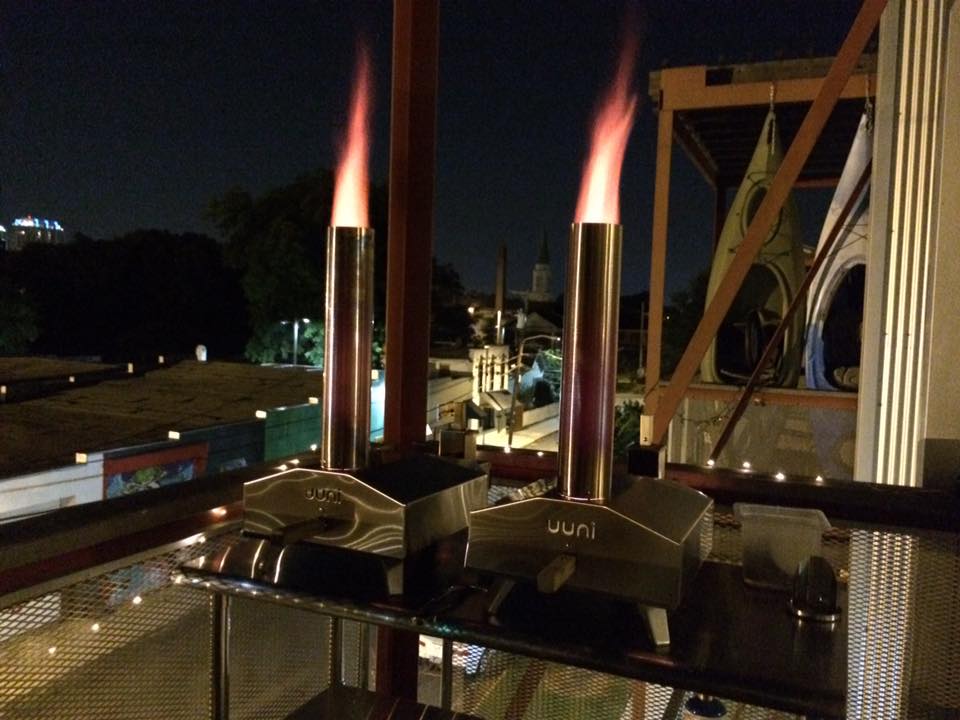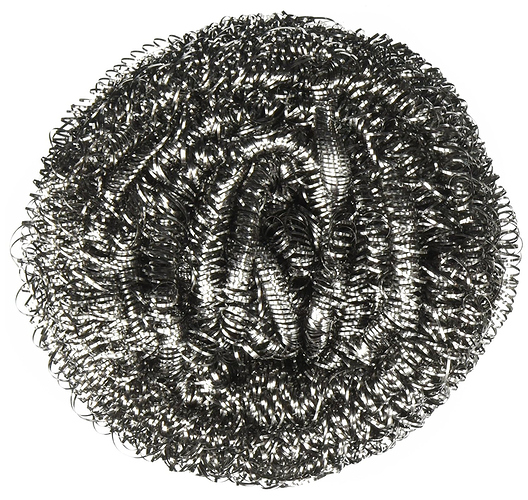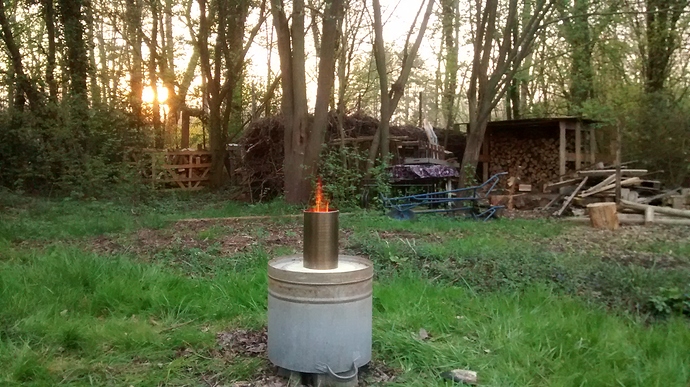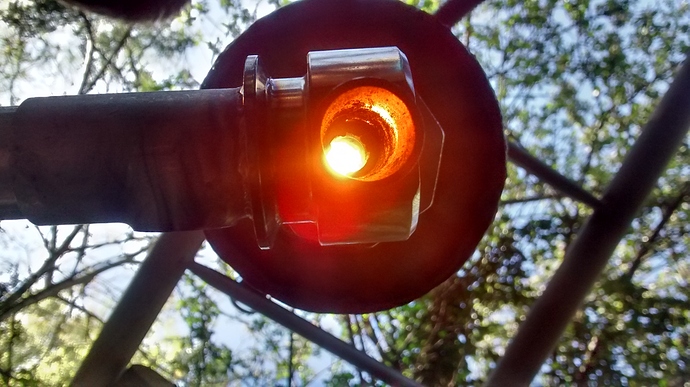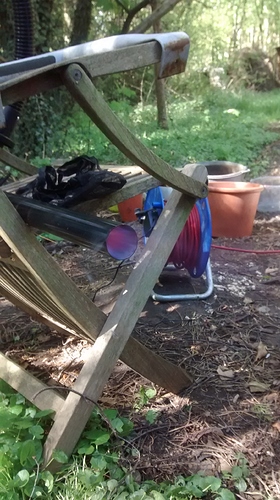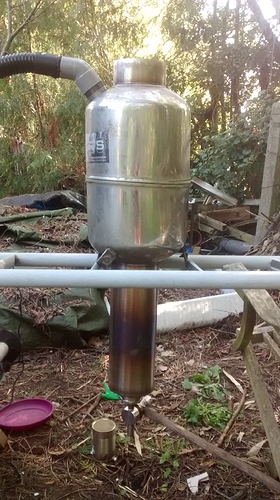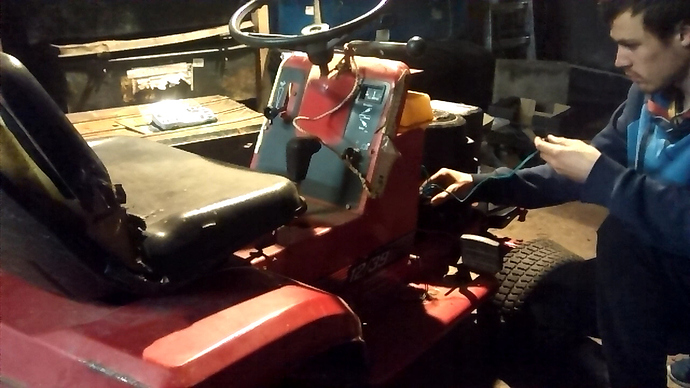Looking good. A TLUD stove makes excellent charcoal. I like to use hardwood feedstock cut the size of a pencil and about 7 CM in length. Load the stove carefully, putting some damp charcoal on the grate, then larger pieces of wood, smaller pieces, and then a bit of charcoal soaked in cooking oil or alcohol fuel. On top of that, some kindling of small paper pieces folded in "V"s. I like small holes in the grate, supplemented (at least in the beginning) by forced air using a small computer fan blowing into the primary air inlet through a plastic bottle or small can. Cook until the flames go out. Dump the contents, and when the charcoal is COLD screen it to get rid of any ash, and to test the “doneness” of the charcoal. The pieces should break easily with your fingers. No brown stuff. No hard pieces of wood.
To light the gasifier, just stick a propane torch into the air inlet with the blower sucking on the output of the unit.
To shut off the air at the end of a run, I like to screw a threaded plug into the air inlet. No air leaks. It is very important to have no air leaks anywhere in the system. The only air introduced into the system (after the air inlet) should be at the mixing valve near the carburetor of the engine. When you get the engine running, mark the location of the lever on the knob of the air valve. I suggest using a watt-hour-meter at the output of the generator so you see how much power you can get out of charcoal with or without EGR or water drip. Inverter Generators are coming down in price. These are neat because the output voltage waveform is a pure sine wave created by an electronic inverter. All the engine does is supply high voltage, normally around 400 volts to the inverter circuit. The carburetors have a servo so they can run at low rpm until a load is added, and then they speed up. (Called ECO mode) My tendency is to run the motor wide open to get maximum power output. No worry about rpm affecting frequency. The inverter takes care of it.
Looking forward to your progress.
I like this design of TLUD for making charcoal.
I use wood chunks in mine similar to what members are using for wood gasification.
Hi Garry, Thanks for the link!
I was already planning to make this one! I try to use recycled materials for my builds but the medium sized buckets where too hard to find. Then I came across this one in our local hardware store.
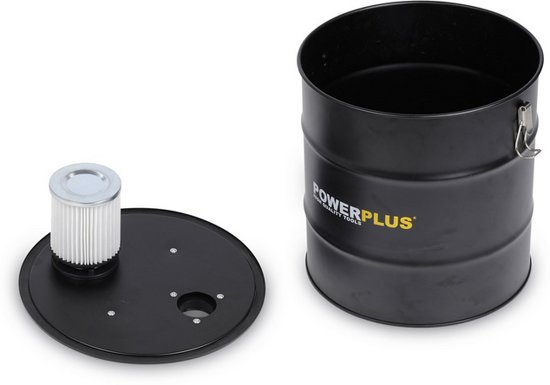
Its a vacuumcleaner adapter to suck ash, so it comes with an airfilter and a vacuum hose so I figured I should support this company for making gasifier starter kits 
-Senne
Great info Ray, I will keep all this in mind!
It seems that I will have to adapt or find a solution on the air nozzle shut-off.
I’ll give the gasifier a test run before doing any welding related adaptions though.
I’ll keep you guys posted, thanks for all the great comments!
-Senne
TLUDding as we speak, got the air/gas mixture reasonable so the flares don’t die. The stove makes higher flares than expected! (Its running on pellets at the moment)
Too much air from underneath?
Yes, too much air through the grate. Here is a photo of a worn-out rusted ten inch saw blade that I used as a grate. (The center air is blocked by an inlet pipe, so very little air goes through it.)
Thanks Ray,
this is my air inlet from underneath, just took a big nail and hammered the holes.
To me, it didn’t look like overkill because the example I followed was the seachar TLUD example:
I will do a test again because the moment I took the flare picture the fire had been raging in the bucket for quite a while when I was adjusting the nuts where the cans rest on (adjusting the air/fuel). The flares got a bit smaller later on. Also note that I only tested with 1/4 of the bucket filled with wood pellets.
-Senne
The grate looks o.k. The intensity of the burn or the height of the flare can also be controlled with the fuel, and the method of loading the fuel. I only use pellets in my Uuni3 wood fired pizza oven
and they are very expensive, including freight. For my TLUD stove, I use junk wood that I cut with a saw and split with a hatchet. You might try putting a bit of char on top of the pellets. They will slow down the velocity. My TLUD is based on the Anderson Champion, and uses a restriction. The bottom of the pot or fry pan is about 18 cm above the restriction, so the flames just touch the bottom of the pot. Sometimes, if certain very dry wood pyrolyzes too fast, I will add even larger cubes or chunks near the grate. I can always tell when my cooking time is about to end because the flames under the pot will suddenly increase in size. If I still have some cooking to do, then I’ll throw in some cubes or even pieces of charcoal, one at a time to slow things down. When I screen and size my charcoal, sometimes there are pieces of wood that didn’t get converted. I save these for in the stove, and they get a second chance to be quality charcoal.
I might add that I live in the Sub-tropics and pellets are not sold in the stores, so they have to be special ordered. However, there are many invasive species of hardwood that can be cut up into little pieces for fuel.
Nicely done. If you get impatient, put a fan under it and take the lid off for BIG flames. See Making Charcoal without Smoke, post 134.
I use classifier screens with wood chips to sift out various sizes. Gases flow much better around chips of similar size.
Ray,
Now l need to know more about your fancy pizza oven. Culd you describe it a bit more? And we do like pictures 
Kristijan,
Since living for some time in Germany and buying bread made in real wood-fired ovens, I’ve wanted to build an outdoor oven to go with all my other outdoor kitchen stoves. My wife bought me the Uuni3 for my birthday, and the package included two bags of special food grade wood pellets. ($25 for 22 pounds!) https://uuni.net/
When the pizza stone reaches 932 F according to a dual laser thermometer, the pizza is placed in the oven and is done in 60 seconds. This is for a thin crust Neapolitan type Pizza. She also bought me the cast-iron sizzler pan for steaks and vegetables. Sometimes, after we make pizza, and there is still quite a bit of heat on the stone, I make some flat breads, with a bit of that wood fired char taste.
Getting back to Senne’s flame photo, my first thought was that he may have had a grate similar to the one in the pellet burner for the Uuni3, where a very large flame is actually desired.
There is a large Facebook group covering Uuni modifications, and another one dealing with recipes and results (Pizza). I believe this last photo of the two flares came from a posting on the FB group, and I can’t give proper credit. There is a new version called the Uuni Pro which has options for pellets, wood, charcoal, or propane as the fuel. It is more expensive.
I’ve watched the uuni from its humble beginnings and a rather clunky prototype. It is now a pretty sleek appliance that is available at Walmart and Amazon.
Me too i really wanted to get a UUni and started saving my money to get one , but then saw a advert 2 for the price of 1 on the "kool grill " and being a charcoal man decided that was the toy for me , let me tell you its the coolest adjustable fan forced charcoal grill and so far no problems after a years use .
Dave
Nice! It seems a bit large but it might do the job as a filter. I would put either a ss or copper chore girl (dish/pot scrubber) in the input and output to stop any flame front coming back from the engine or test burner. No one seems to address this issue except with springs on the gasifier lid. Simple flame arrester. 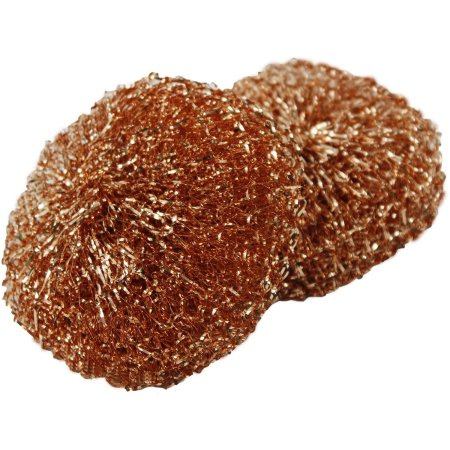 Oops pardon me…Chore Boy not girl (times have changed) They also come in SS but you might have to find them.
Oops pardon me…Chore Boy not girl (times have changed) They also come in SS but you might have to find them.
Sorry about the size they are only about 3 to 4 inches in diameter. I wanted to give you an idea as they would pass the gases and still provide backfire prevention by reducing the flame front temperature .
This is what I did for my mini WK. There are different qualities of these SS scrubbers. Some reason some of them rust. I think people had problems with some that came from China.
Finally some charring and flaring progress!
TLUD stove produces close to 2kg (4,4lbs) of charred woodpellets (pine) after sifting.
A look into the nozzle with blower on full speed.
Flare with no filter
Gasifier after first flare test. Reaction zone might be a touch to high?
I will try to run a riding mower that I was allowed to practice on as a test engine. It’s a 12hp B&S. I had to do some work on it in order to get the starting system ready but it works now.
Got most of the parts for building the filter and carburator so updates will hopefully come soon!
-Senne
Well done Senne, I bet you cant wait to get the engine running now , hope to see more very soon .
Looks like a very neat build and with a vertical nozzle in the bottom ? . tell us more please
Dave
Thanks Dave, can’t wait indeed!
The nozzle is a vertical one. 1/2 inch thick walled stainless steel.
I feel that it might be on the narrow side for running a 12hp engine (I was first planning to run a small generator). But using Koen’s spreadsheet it looks fine in theory. We’ll see how it goes.
-Senne
I’ll never throw another old blade away!

